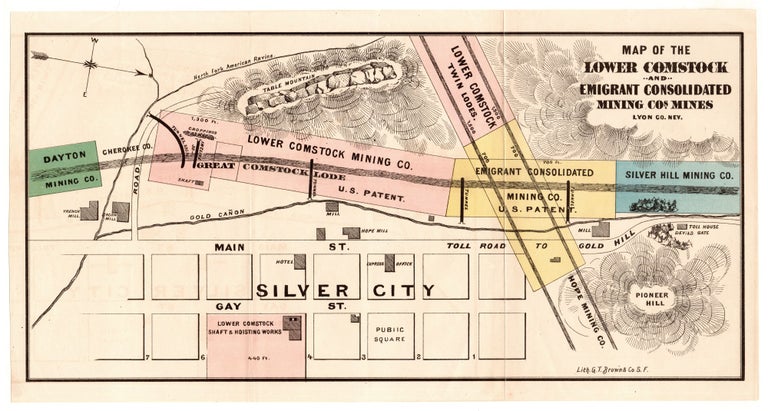Map of the Lower Comstock and Emigrant Consolidated Mining Co.’s Mines, Lyon Co. Nev.
San Francisco: G. T. Brown & Co., [1866]. Chromolithographic map, 7.5” x 15.75”, plus margins. CONDITION: Very good, old folds, barely any wear. A scarce map of the Comstock Lode. mining claims in Lyon County, Nevada, printed by pathbreaking African American lithographer Grafton Tyler Brown. This map extends from a claim owned by Dayton Mining Co. shown on the left (south) to a Silver Hill Mining Co. claim at the far right (north), and from Table Mountain at the top to Silver City below. Gold Cañon extends horizontally across the middle of the map. Each claim bears the name of its owner and its length is given in feet. The claims identified include the Lower Comstock Mining Co., the Emigrant Consolidated Mining Co., the Cherokee Co., and the Hope Mining Co. Also shown are mills (including “Bacon,” and “Hope”), tunnels, a road, and a long ravine. The plan of Silver City indicates a public square, an express office, and a hotel, as well as the Lower Comstock Mining Co.’s shaft and hoisting works. Main Street, also identified as “Toll Road to Gold Hill,” leads to the toll house at “Devil’s Gate” (on the right), a rugged reef of metamorphic rock that was once a famous landmark in Nevada Territory, marking the boundary line between Storey and Lyon Counties. Relief is shown by hachure. The Comstock Lode was a rich silver ore deposit located under the eastern slope of Mt. Davidson, a peak in the Virginia Range in Virginia City, Nevada. The first major silver ore to be discovered in the U.S., it attracted many prospectors from around the world after it was made public in 1859. Mining camps in the vicinity thrived and developed into bustling commercial centers, such as Virginia City. The Comstock Lode generated massive fortunes, simulating the growth of Nevada and San Francisco, and helping to finance the U.S. government during the Civil War. Production at the Comstock mines peaked between 1876 and 1878, and declined sharply thereafter. Born in Harrisburg, Pennsylvania to free African American parents, Grafton Tyler Brown (1841–1918) was the first African American lithographer to work in California. After arriving in Sacramento in 1858, Brown worked as an illustrator, depicting new settlements and gold-rush towns for the San Francisco lithographer Charles Kuchel. Whereas Sacramento’s directories had listed Brown as “colored,” San Francisco’s directories listed the light-skinned Brown as white—giving him a professional advantage. In the early 1860s, Kuchel sent Brown to the Comstock Lode in Nevada, and Brown’s 1861 portrait of Virginia City was the first view created of that boomtown. Following Kuchel’s death in 1864, Brown purchased the lithography business, renaming it G. T. Brown & Co. In 1882 he shifted his focus to landscape painting, working extensively in the Pacific Northwest. Like his bird’s-eye views of Pacific Coast cities and towns, Brown’s landscapes were also popular during his day. In 1892 he relocated to St. Paul, Minnesota, where he worked as a draftsman for the Army Corps of Engineers until 1897, and then with the city’s engineering department until 1910. REFERENCES: Chandler, Robert J. San Francisco Lithographer : African American Artist Grafton Tyler Brown (Norman: University of Oklahoma Press, 2017), pp. 41–47 and 194–195; Chandler, Robert. “Grafton Tyler Brown” at Britannica online; “Devil’s Gate” at Historical Marker Database online.
Item #7724
Sold


